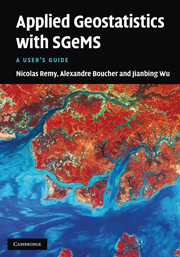Book contents
- Frontmatter
- Contents
- Foreword by Albert Tarantola
- Preface
- List of programs
- List of symbols
- 1 Introduction
- 2 General overview
- 3 Geostatistics: a recall of concepts
- 4 Data sets and SGeMS EDA tools
- 5 Variogram computation and modeling
- 6 Common parameter input interfaces
- 7 Estimation algorithms
- 8 Stochastic simulation algorithms
- 9 Utilities
- 10 Scripting, commands and plug-ins
- Bibliography
- Index
Preface
Published online by Cambridge University Press: 05 November 2011
- Frontmatter
- Contents
- Foreword by Albert Tarantola
- Preface
- List of programs
- List of symbols
- 1 Introduction
- 2 General overview
- 3 Geostatistics: a recall of concepts
- 4 Data sets and SGeMS EDA tools
- 5 Variogram computation and modeling
- 6 Common parameter input interfaces
- 7 Estimation algorithms
- 8 Stochastic simulation algorithms
- 9 Utilities
- 10 Scripting, commands and plug-ins
- Bibliography
- Index
Summary
This book is not an introduction to geostatistics and its theory. Although some elements of geostatistics theory are recalled, the text assumes a reasonable level of familiarity with the main concepts of geostatistics: notions of a random function, stationarity or variogram should not leave you wondering.
The main purpose of this book is to back up the Stanford Geostatistical Modeling Software (SGeMS) and, hopefully, widen the reader's comprehension of geostatistics beyond its theory into its very diverse applications. In that perspective, the emphasis is on practical aspects (in what context should one tool be preferred over another one) and implementation considerations (to what extent do the algorithm implementations deviate from the theory, what are the assumptions and limitations of the implementation). However, this book is not a reference manual to programming in SGeMS and no details about the source code of SGeMS or its APIs are given. If you are interested in learning how to contribute code to SGeMS please refer to the SGeMS web site, http://sgems.sourceforge.net, where a description of the SGeMS APIs and several tutorials are available.
The geostatistics tools of SGeMS were designed to provide enough flexibility to adapt to very different problems. As a result, the number of available control parameters may seem daunting to the novice practitioner. Don't be intimidated! Most of the advanced parameters have default values, and the best way to build up your understanding of those parameters is to repeat the example runs and experiment on your own.
- Type
- Chapter
- Information
- Applied Geostatistics with SGeMSA User's Guide, pp. xi - xiiPublisher: Cambridge University PressPrint publication year: 2009



